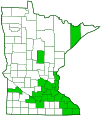leaf-footed bug
(Acanthocephala terminalis)
Conservation • Description • Habitat • Ecology • Distribution • Taxonomy
|
|
|||||||||||||
Description |
Acanthocephala terminalis is a terrestrial, widespread, and frequently encountered, true bug. It is a relatively large bug (order Hemiptera) but a small leaf-footed bug (genus Acanthocephala), the smallest in North America north of Mexico. Adults are 11 ⁄16″ to ⅞″ in length. The body is fairly hard and reddish-brown to nearly black. The front thoracic shield (pronotum) is covered with short, gold-colored hairs and with small bumps (tubercles). There are two pairs of wings. They are held flat over the body when at rest. They are longer than the body but do not completely cover the sides of the body. Between and at the wing bases there is a triangular plate (scutellum). The forewings (hemelytra) on the mature adult are longer than the abdomen but do not completely cover the sides of the abdomen. They have a thickened section at the base and a thin membranous section at the tip with a clear dividing line between the two. The thickened basal part is comprised of a narrow area (clavus) behind the scutellum when the wings are closed, and the remaining broad marginal area (corium). The hindwings are thin, membranous, and concealed under the forewings. The head is small, much narrower and somewhat shorter than the pronotum. There is a pair of large compound eyes and a pair of small simple eyes (occelli). The mouth parts are optimized for piercing and sucking. They take the form of a long, 4-segmented beak. The beak projects in front of the head and extends along the underside of the body between the legs. It consists of 4 hair-like blades (stylets) with sharp tips enclosed in a 4-segmented sheath. There are two channels in the beak, one spitting out saliva to keep the food flowing, and one for sucking in liquid food. The two lower jaw-like structures (maxillae) and two lower lips do not have feeler-like structures (palps) attached. The antennae are exposed, conspicuous, and long, much longer than the head. They have four segments, the basal three dark reddish-brown, the terminal segment bright yellowish-orange. The third segment (femur) of the hind leg is is stout and either parallel-sided or only slightly expanded toward the end (apex). The fourth segment (tibia) is greatly dilated and scalloped in the basal half, gradually narrowing beyond the middle toward apex, and not at all dilated in the final third. The female tibia is less dilated than the male tibia. The feet (tarsi) have only 3 segments. The tarsi on all legs and the femurs on the front and middle legs are frequently orange or orangish. |
Size |
Total length: 11 ⁄16″ to ⅞″ |
Similar Species |
Habitat |
Open woods, woodland borders and paths, thickets, and roadsides. |
Ecology |
Season |
One generation per year: early June to late September |
Behavior |
They are easily disturbed and are rapid fliers. When handled they squirt a foul-smelling chemical from glands on the sides of their bodies that is an effective deterrent. Immature individuals are usually concealed, either on the underside of a leaf or on the stem of a plant. |
Life Cycle |
Bright whitish eggs are deposited singly from mid-June to mid-July. The eggs hatch in 7 to 14 days. The young (nymphs) pass through 5 instar stages in 5 to 10 weeks (mean time 58 days) before becoming an adult. The mean number of days spent as the first through fifth instars is 4, 13, 13, 10, and 19, respectively. Adults overwinter. |
Nymph Food |
Sap from petioles and stems of common ninebark (Physocarpus opulifolius), staghorn sumac (Rhus typhina), and wild grape (Vitis riparia). |
Adult Food |
Plant sap. Adults have been observed on bird droppings but it is not known if they feed on the droppings. |
Distribution |
||
|
Sources |
|
| 6/12/2024 | ||
Occurrence |
||
Widespread and frequently encountered |
||
Taxonomy |
|
Order |
Hemiptera (True bugs, Hoppers, Aphids, and Allies) |
Suborder |
Heteroptera (True Bugs) |
Infraorder |
Pentatomomorpha |
Superfamily |
Coreoidea (leaf-footed bugs and allies) |
Family |
Coreoidea (leaf-footed bugs) |
Subfamily |
Coreinae |
Tribe |
Acanthocephalini |
Genus |
Acanthocephala (spine-headed bugs) |
There are 25 known Acanthocephala species worldwide, 5 of which occur in North America north of Mexico. Among these, Acanthocephala terminalis has by far the widest distribution, and it is the only one found in Minnesota. |
|
Subordinate Taxa |
|
|
|
Synonyms |
|
Acanthocephala confraterna Metapodius confraternus Metapodius terminalis |
|
Common Names |
|
This species has no common name. The common name for the family Coreidae is leaf-footed bugs, and it is applied here for convenience. |
|
Glossary
Femur
On insects and arachnids, the third, largest, most robust segment of the leg, coming immediately before the tibia. On humans, the thigh bone.
Hemelytron
The forewing of true bugs (order Hemiptera), thickened at the base and membranous at the tip. Plural: hemelytra.
Instar
The developmental stage of arthropods between each molt; in insects, the developmental stage of the larvae or nymph.
Ocellus
Simple eye; an eye with a single lens. Plural: ocelli.
Petiole
On plants: The stalk of a leaf blade or a compound leaf that attaches it to the stem. On ants and wasps: The constricted first one or two segments of the rear part of the body.
Pronotum
The exoskeletal plate on the upper side of the first segment of the thorax of an insect.
Scutellum
The exoskeletal plate covering the rearward (posterior) part of the middle segment of the thorax in some insects. In Coleoptera, Hemiptera, and Homoptera, the dorsal, often triangular plate behind the pronotum and between the bases of the front wings. In Diptera, the exoskeletal plate between the abdomen and the thorax.
Tarsus
On insects, the last two to five subdivisions of the leg, attached to the tibia; the foot. On spiders, the last segment of the leg. Plural: tarsi.
Tibia
The fourth segment of an insect leg, after the femur and before the tarsus (foot). The fifth segment of a spider leg or palp. Plural: tibiae.
Visitor Photos |
||
Share your photo of this insect. |
||
This button not working for you? |
||
Alfredo Colon |
||
 |
 |
|
 |
 |
|
 |
 |
|
 |
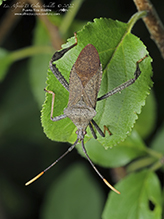 |
|
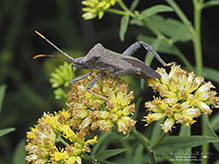 |
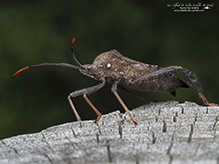 |
|
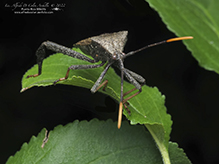 |
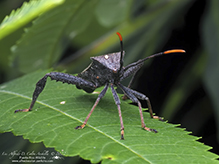 |
|
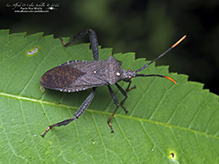 |
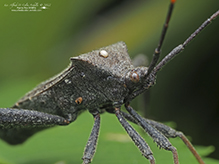 |
|
Yana G. |
 |
Saw this big leaf-footed bug on a path in the woods of northern Washington County, MN |
Amy Lindberg |
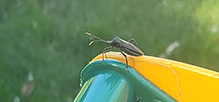 |
One found in my car last week and one on my garbage can today. |
MinnesotaSeasons.com Photos |
||
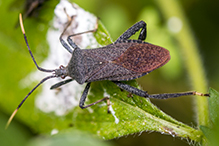 |
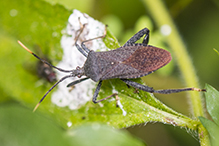 |

Slideshows |
|

Visitor Videos |
||
Share your video of this insect. |
||
This button not working for you? |
||
|
Other Videos |
||
Leaf Footed BUG - Acanthocephala terminalis |
About
Published on Apr 23, 2012 |
Leaf-footed Bug |
About
Published on Jun 7, 2012 Acanthocephala terminalis - On the deck, Poconos, PA |

Visitor Sightings |
||
Report a sighting of this insect. |
||
This button not working for you? |
||
Alfredo Colon |
Location: Albany, NY |
 |
Alfredo Colon |
Location: Albany, NY |
 |
Alfredo Colon |
Location: Albany, NY |
 |
Alfredo Colon |
Location: Albany, NY |
 |
Alfredo Colon |
Location: Albany, NY |
 |
Yana G. |
Location: Washington County Saw this big leaf-footed bug on a path in the woods of northern Washington County, MN |
 |
Amy Lindberg |
Location: Stillwater, MN One found in my car last week and one on my garbage can today. |
| Alfredo Colon 8/23/2022 |
Location: Albany, NY |
 |
| Alfredo Colon 8/16/2022 |
Location: Albany, NY |
 |
| Alfredo Colon 8/11/2022 |
Location: Albany, NY |
 |
MinnesotaSeasons.com Sightings |
||

Created: 3/18/2019 Last Updated: © MinnesotaSeasons.com. All rights reserved. |
